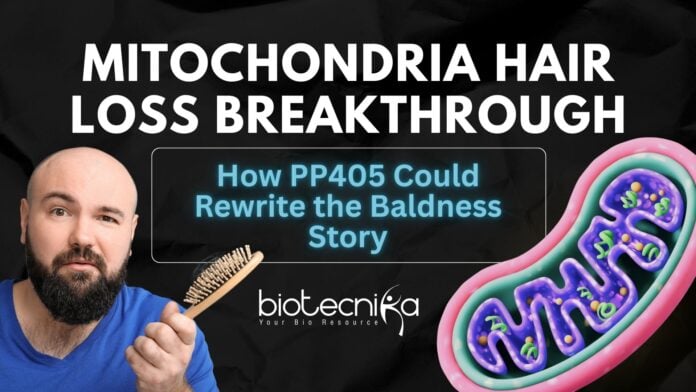PP405 Mitochondria Breakthrough: Could This Drug End Baldness Forever?
For years, the battle against baldness has been fought with patience, painful procedures, and a fair bit of pocket draining. Today, the researchers believe they have found a smarter weapon to win this battle.
This weapon is named PP405, a topical drug designed to reactivate hair follicles and bring back your hair. It’s just like a light in a long-abandoned house. With early trials showing remarkable results in just weeks, the whispers of an “Unbalding Era” are rising.
But is it truly a game-changer or just another overhyped promise? Let’s uncover the story behind this secret weapon.
What is PP405 and How Does It Work?
Developed by Pelage Pharmaceuticals and based on research from the University of California, Los Angeles, PP405 is a first-of-its-kind topical therapy. It was created to awaken dormant hair follicles. Its unique mechanism targets mitochondrial pyruvate carriers (MPCs). These tiny transport proteins inside cells are responsible for controlling energy flow.
By blocking MPCs, PP405 shifts the follicle’s metabolism, activating stem cells that have been lying inactive. This reactivation can kick-start the growth of terminal (thick) hair, not just the fine, wispy strands some treatments produce.
The approach is different from current mainstays like minoxidil and finasteride. During those treatments mainly slow hair loss or improve blood supply, PP405’s goal is to regenerate hair by reawakening the follicles themselves, a deeper, more targeted intervention.
What Do the Clinical Trials Show?
Phase 1: Safety and Proof of Concept
The first human studies confirmed that PP405 is well tolerated and remains localized in the scalp, meaning it doesn’t enter the bloodstream in measurable amounts. In as little as seven days, researchers saw markers of increased follicle stem-cell activity, a promising sign that the drug was doing what it was designed to do.
Phase 2a: Early Signs of Regrowth
In a randomized, double-blind, placebo-controlled trial involving 78 men aged 18–55 with androgenetic alopecia (pattern baldness), 31% of participants receiving PP405 saw a hair density increase of over 20% in just eight weeks. By contrast, the placebo group saw no such gains.
The drug continued to demonstrate a clean safety profile, with no systemic side effects. This makes it more attractive when compared to oral finasteride, which can cause hormonal risks.
Phase 2b and Beyond
PP405 is now in Phase 2b trials, expected to wrap up by the end of 2025. If results hold, Phase 3 trials could begin in 2026. Should those succeed, the drug could reach markets between 2027 and 2030, pending regulatory approvals.
How Does PP405 Mitochondria Breakthrough Compare to Current Options?
| Feature | Minoxidil / Finasteride | PP405 |
| Mechanism | Slows hair loss via blood flow or hormone modulation | Regenerates hair via stem-cell reactivation |
| Delivery | Topical (minoxidil) / Oral (finasteride) | Topical only |
| Side Effects | Irritation, hormonal effects | None reported so far, no systemic absorption |
| Time to Results | 6–12 months | Visible changes in 1–8 weeks |
Community Perspective: Hope with a Dose of Realism
Apart from clinical data, talks about PP405 are flowing in patient forums and dermatology groups. It reveals cautious optimism. Many agree that PP405 is still in early stages because its results are exciting. But they are also stressed about the importance of waiting for the science to catch up with the hype.
Some hair-loss researchers point out that while PP405 may successfully reactivate dormant follicles, it’s still unclear whether it can fully restore follicles that have significantly miniaturized over time. Others note that with Phase 2b trials still underway, and final results expected toward the end of 2025, there’s simply not enough long-term data to predict how lasting or universal the benefits will be.
Could India See PP405 in Its Clinics?
India’s hair-restoration market is already booming, with hair transplants becoming more affordable and accessible. A safe, non-invasive alternative like PP405 could be a game-changer, especially for the millions affected by androgenetic alopecia.
Dr. Sandip Agnihotri, Consultant dermatologist, said that dermatologists have been waiting for better alternatives to minoxidil or finasteride. He believes that PP405 is the safest alternative till now, but post-market trials are still important.
Medical Director of Isya Aesthetics, Dr. Kiran Kaur Sethi, confirms that Phase 2 is completed. She urges everyone to wait till Phases 3 and 4 are completed and the side effects are understood.
If approvals go smoothly overseas, India could potentially see PP405 within a few years, especially given its large patient population and strong cosmetic dermatology sector.
Is “Unbalding” the Next Medical Revolution?
PP405 represents one of the most intriguing advances in hair-loss science in decades. Its metabolic approach to follicle reactivation offers a fresh path forward, one that’s faster, potentially safer, and more targeted than existing treatments.
Still, caution is key. The leap from early trials to market success can be rapid, and history is filled with “miracle” hair treatments.
The next 2–5 years will determine whether PP405 is a genuine game-changer or another footnote in the long war against baldness.
For now, PP405 Mitochondria Breakthrough remains a beacon of hope in a field that hasn’t seen a major breakthrough in decades. And if the “Great Unbalding” ever truly begins, PP405 might just be the spark that lights it.























